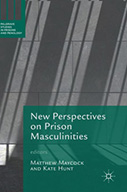New Perspectives On Prison Masculinities

Editors: Matthew Maycock and Kate Hunt
Publisher: Cham, SWIT: Palgrave, 2018. 343p.
Reviewers: Rosemary Ricciardelli and Navjotpal Kaur | September 2020
Internationally, the truth remains that prisons are sex segregated yet highly gendered spaces with an overrepresentation of adult males (e.g., over 90% of the world’s prisoners are male), a fact that is not always acknowledged in scholarship, practice, and policy. Edited and introduced by Matthew Maycock and Kate Hunt, New Perspectives on Prison Masculinities is an eclectic and comprehensive anthology that unpacks prison masculinities in an exhilarating and, as promised in the title, new way. To this end, the collection provides an oddly befitting context to reflect on a quote by Sabo, Kupers, and London (2001), that “prison is an ultramasculine world where nobody talks about masculinity,” even after nearly 20 years. One could interpret said ‘standstill’ as having the potential to incite critical implications for penology as a discipline; a potential which this collection clearly accomplishes.
Contributors draw on various methodological and conceptual approaches, including autoethnography, participant observation, and program evaluation, to interpret masculinities within prison. The editors include contributions from scholars in the United Kingdom, the United States, and Australia, yet perhaps attributable in part to the caliber of scholarship, the greater international appeal is clearly apparent. To start the collection, Maycock situates his introduction in the theory of hegemonic masculinities, and with Hunt throughout the collection, elucidates how the concept developed in non-prison contexts, but has been widely availed of in the study of masculinities within the prison. In highlighting the suitability of the theory of ‘inclusive masculinities’ for prison research, Maycock and Hunt succeed at creating a collection that addresses a lacunae in the literature — the need to centralize gender in prison studies by recognizing the full complexities of and the nuances inherent to gender and its performativity (acting out) in said spaces. For example, Morey and Crewe write here that “the focus of much research into prison masculinities has been troublingly narrow, concentrating on their most spectacular and stereotypical manifestations” (p. 17). Of course, in the defense of masculinities scholars, violence remains in prison and does hold a role in shaping prison masculinities that can and do include a hypermasculine component. This collection is a welcome movement past such normative interpretations of masculinities to highlight the vulnerabilities of incarcerated males and the complexities of what it means to be a man in prison.
To this end, the collection is distinctive; always problematizing the reduction of prison masculinities to masculinities with destructive and hypermasculine qualities (see the Morey and Crew, de Viggiani and Seymour contributions). These authors, not ignoring the fact that violence in prison does play a role in gender presentation and management of self, recognize the array of qualities, some culturally read as being masculine and others as more feminine, that shape prisoners’ gender.
In a number of contributions, authors provide insight into and reviews of programs that develop positive and inclusive masculinities. For instance, Brown and Grant, in their evaluation of a faith-based intervention speak to inclusive masculinities and the intersection of race and ethnicity with prison masculinities.
Collectively, the contributors challenge the stereotype that prisons serve to reproduce destructive forms of masculinities and instead reveal the complexities and humanity beneath the presentation and development of gender within prisons. For example, Curtis highlights how group facilitators’ during prison programming at a youth and adult facility struggle with the “very real structural barriers” faced by prisoners who want to improve their relationships with their children (p. 327). She acknowledges the incongruity that arises for prisoners because of the perceived expectations of being a “man” yet also a “father” (see also Evans). Buston too writes of fatherhood in prison. Focusing on young incarcerated fathers, she asks “does the hypermasculine prison code permit exceptions to the general rules for dads?” She leaves the reader to ponder over the potential multifold answers to this question that might have the capacity to open whole new avenues for future researchers keen to further understand the different masculine performativities available to incarcerated fathers and how such performativities may differ with age. Overall, the authors make valuable contributions to knowledge on incarcerated fathers from the perspectives of prisoners as well as that of program facilitators, providing insights into measures required to improve the success of related programs.
In sum, these contributors move beyond the notion of prisons as hypermasculine and violent spaces to reveal the emotional qualities of masculinities and the complicities of masculinities among prisoners and within prisons. Maycock and Hunt have created a book where, collectively, the theoretical, conceptual, and evaluative frameworks across chapters open avenues for future research, in penology and criminal justice, aimed at undertaking more nuanced approaches in order to comprehend and investigate the various permutations.
Rosemary Ricciardelli and Navjotpal Kaur; Memorial University of Newfoundland *Corresponding Author, 709 864 7446, rricciardell@mun.ca, AA 4066, Department of Sociology, HSS, 232 Elizabeth Ave., St. John’s, Newfoundland, A1C 4S7


